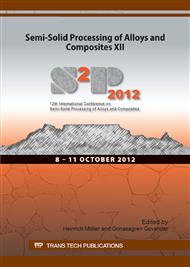p.521
p.527
p.533
p.539
p.545
p.551
p.556
p.562
p.569
Extremely Light Weight Rheocast Components for Automotive Space Frame
Abstract:
This paper presents an analysis of a new rheocasting process suitable for the manufacturing of high performance automotive parts. The process is able for the realization of components using Al alloys. An important aspect is related to the possibility to obtain quite wide range of thicknesses, starting from 2.5 mm. The used alloy is the well known A356, with low Fe content, maximum 0.08 wt%. T6 heat treatments has been performed, while the soundness of the parts has been certified by non destructive tests. These parts are produced to be mounted on a top level and famous sport car. Non standard samples for mechanical tests have been machined directly from the components. Following the mechanical tests fracture surface analysis has been carried out by SEM to observe some morphological details and to evaluate the influence of the process and of the alloy conditions on the fracture behaviour. On the polished transverse sections of the samples morphological analysis has been performed. The obtained results shown high level of mechanical strength for all series of components. The reliability of the process is very high at a convenient level of manufacturing rate. The weldability of the parts has been demonstrated.
Info:
Periodical:
Pages:
545-550
Citation:
Online since:
October 2012
Authors:
Price:
Сopyright:
© 2013 Trans Tech Publications Ltd. All Rights Reserved
Share:
Citation:


